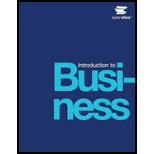
Introduction to Business
OER 2018 Edition
ISBN: 9781947172548
Author: OpenStax
Publisher: OpenStax College
expand_more
expand_more
format_list_bulleted
Textbook Question
Chapter 1.4, Problem 3CC
What is the difference between demand-pull and cost-push inflation?
Expert Solution & Answer
Want to see the full answer?
Check out a sample textbook solution
Students have asked these similar questions
Subject : Financial Accounting
Determine the effect of the following transaction on the accounting
equation: Received cash for services provided.
a. Increase assets, increase liabilities
b. Increase liabilities, decrease owner's equity
c. Increase assets, increase owner's equity
d. No effect
e. Decrease assets, decrease liabilities
f. Decrease assets, decrease owner's equity
Need solution in this financial account subject questions
Chapter 1 Solutions
Introduction to Business
Ch. 1.1 - Explain the concepts of revenue, costs, and...Ch. 1.1 - What are the five factors of production?Ch. 1.1 - What is role of an entrepreneur is society?Ch. 1.2 - Define the components of the internal and the...Ch. 1.2 - What factors within the economic environment...Ch. 1.2 - Why do demographic shifts and technological...Ch. 1.3 - What is economics, and how can you benefit from...Ch. 1.3 - Compare and contrast the world's major economic...Ch. 1.3 - What is the difference macroeconomics and...Ch. 1.4 - What is a business cycle? How do businesses adapt...
Ch. 1.4 - Why is full employment usually defined as a target...Ch. 1.4 - What is the difference between demand-pull and...Ch. 1.5 - What are the two kinds of monetary policy?Ch. 1.5 - What fiscal policy tools can the government use to...Ch. 1.5 - What problems can a large national debt present?Ch. 1.6 - What is the relationship between prices and...Ch. 1.6 - How is market equilibrium achieved? Describe the...Ch. 1.6 - Draw a graph that shows an equilibrium points for...Ch. 1.7 - What is meant by market structure?Ch. 1.7 - Compare and contrast perfect completion and pure...Ch. 1.7 - How does an oligopoly differ from monopolistic...Ch. 1.8 - What steps can companies take to benefit from the...Ch. 1.8 - Why is the increasing demand for energy worldwide...Ch. 1.8 - Describe several strategies that companies can use...Ch. 1 - Ethics Activity Historically, diesel cars have not...Ch. 1 - What are some advantages of Walmart purchasing...Ch. 1 - What impact is Walmart's acquisition of...Ch. 1 - How will the aggressive e-commerce plan...
Additional Business Textbook Solutions
Find more solutions based on key concepts
(Record inventory transactions in the periodic system) Wexton Technologies began the year with inventory of 560...
Financial Accounting (12th Edition) (What's New in Accounting)
(Capital asset pricing model) Using the CAPM, estimate the appropriate required rate of return for the three st...
Foundations Of Finance
11-13. Discuss how your team is going to identify the existing competitors in your chosen market. Based on the ...
Business Essentials (12th Edition) (What's New in Intro to Business)
4. JC Manufacturing purchase d inventory for $ 5,300 and al so paid a $260 freight bill. JC Manufacturing retur...
Horngren's Financial & Managerial Accounting, The Financial Chapters (Book & Access Card)
E2-13 Identifying increases and decreases in accounts and normal balances
Learning Objective 2
Insert the mis...
Horngren's Accounting (12th Edition)
Quick ratio (Learning Objective 7) 510 min. Calculate the quick assets and the quick ratio for each of the foll...
Financial Accounting, Student Value Edition (5th Edition)
Knowledge Booster
Similar questions
- 4 PTSarrow_forwardGeneral accountingarrow_forwardTumbling Haven, a gymnastic equipment manufacturer, provided the following information to its accountants. The company had current assets of $158,332, net fixed assets of $416,190, and other assets of $5,176. The firm has long-term debt of $76,445, common stock of $330,000, and retained earnings of $144,461. What amount of current liabilities does this firm have?arrow_forward
arrow_back_ios
SEE MORE QUESTIONS
arrow_forward_ios
Recommended textbooks for you
 Foundations of Business (MindTap Course List)MarketingISBN:9781337386920Author:William M. Pride, Robert J. Hughes, Jack R. KapoorPublisher:Cengage Learning
Foundations of Business (MindTap Course List)MarketingISBN:9781337386920Author:William M. Pride, Robert J. Hughes, Jack R. KapoorPublisher:Cengage Learning Foundations of Business - Standalone book (MindTa...MarketingISBN:9781285193946Author:William M. Pride, Robert J. Hughes, Jack R. KapoorPublisher:Cengage LearningMarketingMarketingISBN:9780357033791Author:Pride, William MPublisher:South Western Educational Publishing
Foundations of Business - Standalone book (MindTa...MarketingISBN:9781285193946Author:William M. Pride, Robert J. Hughes, Jack R. KapoorPublisher:Cengage LearningMarketingMarketingISBN:9780357033791Author:Pride, William MPublisher:South Western Educational Publishing

Foundations of Business (MindTap Course List)
Marketing
ISBN:9781337386920
Author:William M. Pride, Robert J. Hughes, Jack R. Kapoor
Publisher:Cengage Learning

Foundations of Business - Standalone book (MindTa...
Marketing
ISBN:9781285193946
Author:William M. Pride, Robert J. Hughes, Jack R. Kapoor
Publisher:Cengage Learning

Marketing
Marketing
ISBN:9780357033791
Author:Pride, William M
Publisher:South Western Educational Publishing
